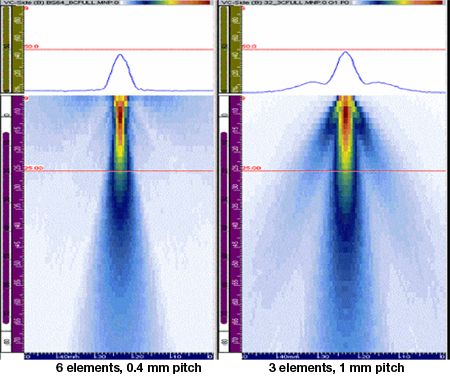Grating Lobes and Side Lobes
Another phenomenon associated with phased array probes is the generation of unwanted grating lobes or side lobes, two closely related phenomena caused by sound energy that spreads out from the transducer at angles other than the primary path. This phenomenon is not limited to phased array systems -- unwanted lobes also occur with conventional transducers as element size increases. These unwanted ray paths can reflect off surfaces in the test piece and cause spurious indications on an image. The amplitude of grating lobes is significantly affected by pitch size, the number of elements, frequency, and bandwidth. The beam profiles below compare two situations where the probe aperture is approximately the same, but the beam at left is generated by six elements at 0.4 mm pitch and the beam at right by three elements at 1 mm pitch. The beam at left is approximately shaped as a cone, while the beam at right has two spurious lobes at approximately a 30 degree angle to the center axis of the beam.
Grating lobes will occur whenever the size of individual elements in an array is equal to or greater than the wavelength, and there will be no grating lobes when element size is smaller than half a wavelength. (For element sizes between one-half and one wavelength, the generation of grating lobes will depend on the steering angle.) Thus the simplest way to minimize grating lobes in a given application is to use a transducer with a small pitch. Specialized transducer design incorporating subdicing (cutting elements into smaller elements) and varying element spacing will also reduce unwanted lobes.
Continue on to
Focusing With Phased Array Probes >>
